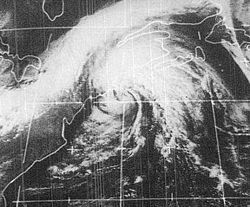Mid-Atlantic
Carrie had minimal effects on the U.S. East Coast south of the Mid-Atlantic states, limited to moderate winds and generally light rainfall. Precipitation at Norfolk, Virginia, reached 1.12 inches (28 mm) between September 1 and 3, and pressure fell to a modest 1,012 mb (29.9 inHg). Sustained winds were recorded at 28 mph (45 km/h), with only slightly higher gusts, although the Chesapeake Light unofficially reported gusts to near 50 mph (80 km/h). Damage in the area was minimal with the exception of beach erosion, and tides 2.5 feet (0.76 m) above normal triggered minor flooding. [12] Moderate rainfall, approaching or reaching 5 in (130 mm), fell across the southern Delmarva Peninsula. [13] Equally minor effects were felt in the Atlantic City, New Jersey, area, with comparable or even less significant reports of winds and rainfall and damages limited to coastal flooding and beach erosion. Since the adverse weather conditions fell on a portion of the Labor Day weekend, the local resort industry suffered economical losses. [14]
New England and Canada
The brunt of the storm occurred in southeastern New England, particularly coastal Massachusetts, where strong gusts battered the shore. [11] The distribution of winds resulting from the storm more closely resembled that of a nor'easter than a cyclone of tropical origin, in which the wind field would typically be concentrated closer to its center. Instead, the strongest winds remained well removed from the center of circulation, but were nonetheless severe; gusts reached 84 mph (135 km/h) at Point Judith, Rhode Island, and 69 mph (111 km/h) on Cape Cod, Massachusetts. Sustained winds throughout the region were generally below 50 mph (80 km/h). In Boston, Massachusetts, winds gusted to 46 mph (74 km/h). The storm brought down trees and powerlines, blocking roads and damaging property. Structural damage was also evident, especially to buildings under construction, and an entire cottage in Rockland, Maine, was blown off its foundation. [15]
Rainfall in southeastern New England was heavy, locally exceeding 10 in (250 mm). On the island of Martha's Vineyard, a storm total of 12.5 in (320 mm) was reported, the highest known precipitation sum resulting from Carrie. The most torrential rains were usually confined to within 70 mi (110 km) of the coast. The deluge swelled streams, inundated cellars, and washed out a railroad near Eagle Lake, Maine, derailing a train. Along the coast, rough surf caused beach erosion and swamped hundreds of small craft. [15] On September 3, choppy conditions forced the suspension of steamship services to and from the mainland and the islands of Martha's Vineyard and Nantucket. Thousands of tourists and seasonal residents became stranded on the islands, creating what officials described as a "logistical problem". [16]
During the height of the storm, around 20,000 Narragansett Electric Company customers lost power, with scattered power outages reported elsewhere throughout New England. [17]
Damage from Tropical Storm Carrie and its extratropical remnants was light. [17] Total monetary damage was estimated at $1,780,000 (equivalent to $13,380,000in 2024 [18] ), of which $1,200,000 in losses was inflicted on Massachusetts. Losses totaled $350,000 in Rhode Island, $200,000 in Maine, and $30,000 in New Hampshire. [19] Four fatalities were attributed to the storm: two in the aftermath of boating accidents in Massachusetts, and two due to rough surf along the coast of Maine. In the aftermath, a local disaster area was declared for the town of Plymouth. [15]
The weakening remnants of Carrie produced strong winds throughout New Brunswick on September 4. In Saint John, where wind gusts reached 97 km/h (60 mph), there were reports of downed telephone wires and trees. Widespread power outages occurred throughout communities in the province. Despite well over an inch of rain at Saint John, no flooding was evident. Fredericton also received fairly heavy rain and gusty wind on the 4th, which was its wettest day of the month but not its windiest. The storm damaged or destroyed numerous boats in Charlo, New Brunswick. [20] [21] [22]
Oceanic currents produced by the storm washed cells of the harmful alga Alexandrium fundyense south and west into the coastal waters of New England. The alga releases toxins that cause shellfish poisoning and is native to the Bay of Fundy. Several weeks after the storm, a massive bloom of the alga occurred offshore the northeastern United States for the first time, and the species bloomed every year post-Carrie. [23]



